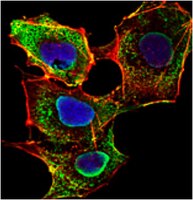MABT521 Sigma-AldrichAnti-SMAD3, clone 5G11 Antibody
Anti-SMAD3, clone 5G11 Antibody is an antibody against SMAD3 for use in Western Blotting and Immunocytochemistry.
More>> Anti-SMAD3, clone 5G11 Antibody is an antibody against SMAD3 for use in Western Blotting and Immunocytochemistry. Less<<Anti-SMAD3, clone 5G11 Antibody MSDS (material safety data sheet) or SDS, CoA and CoQ, dossiers, brochures and other available documents.
Recommended Products
概述
| Replacement Information |
|---|
重要规格表
| Species Reactivity | Key Applications | Host | Format | Antibody Type |
|---|---|---|---|---|
| H, M | WB, ICC | M | Ascites | Monoclonal Antibody |
| References |
|---|
| Product Information | |
|---|---|
| Format | Ascites |
| Presentation | Mouse monoclonal IgG1ascitic fluid containing 0.03% sodium azide. |
| Quality Level | MQ100 |
| Physicochemical Information |
|---|
| Dimensions |
|---|
| Materials Information |
|---|
| Toxicological Information |
|---|
| Safety Information according to GHS |
|---|
| Safety Information |
|---|
| Packaging Information | |
|---|---|
| Material Size | 100 µL |
| Transport Information |
|---|
| Supplemental Information |
|---|
| Specifications |
|---|
| Global Trade Item Number | |
|---|---|
| 产品目录编号 | GTIN |
| MABT521 | 04055977171518 |
Documentation
Anti-SMAD3, clone 5G11 Antibody 分析证书
| 标题 | 批号 |
|---|---|
| Anti-SMAD3, clone 5G11 | VP1606072A |
| Anti-SMAD3, clone 5G11 - VP1911085 | VP1911085 |
| Anti-SMAD3, clone 5G11 - VP2304201 | VP2304201 |
| Anti-SMAD3, clone 5G11 -VP1512155 | VP1512155 |
| Anti-SMAD3, clone 5G11 -VP1606072 | VP1606072 |
| Anti-SMAD3, clone 5G11 Monoclonal Antibody | VP1806294 |
技术信息
| 标题 |
|---|
| Characterization of Estrogen Receptor α Phosphorylation Sites in Breast Cancer Tissue Using the SNAP i.d® 2.0 System |
| White Paper: Further considerations of antibody validation and usage. |








